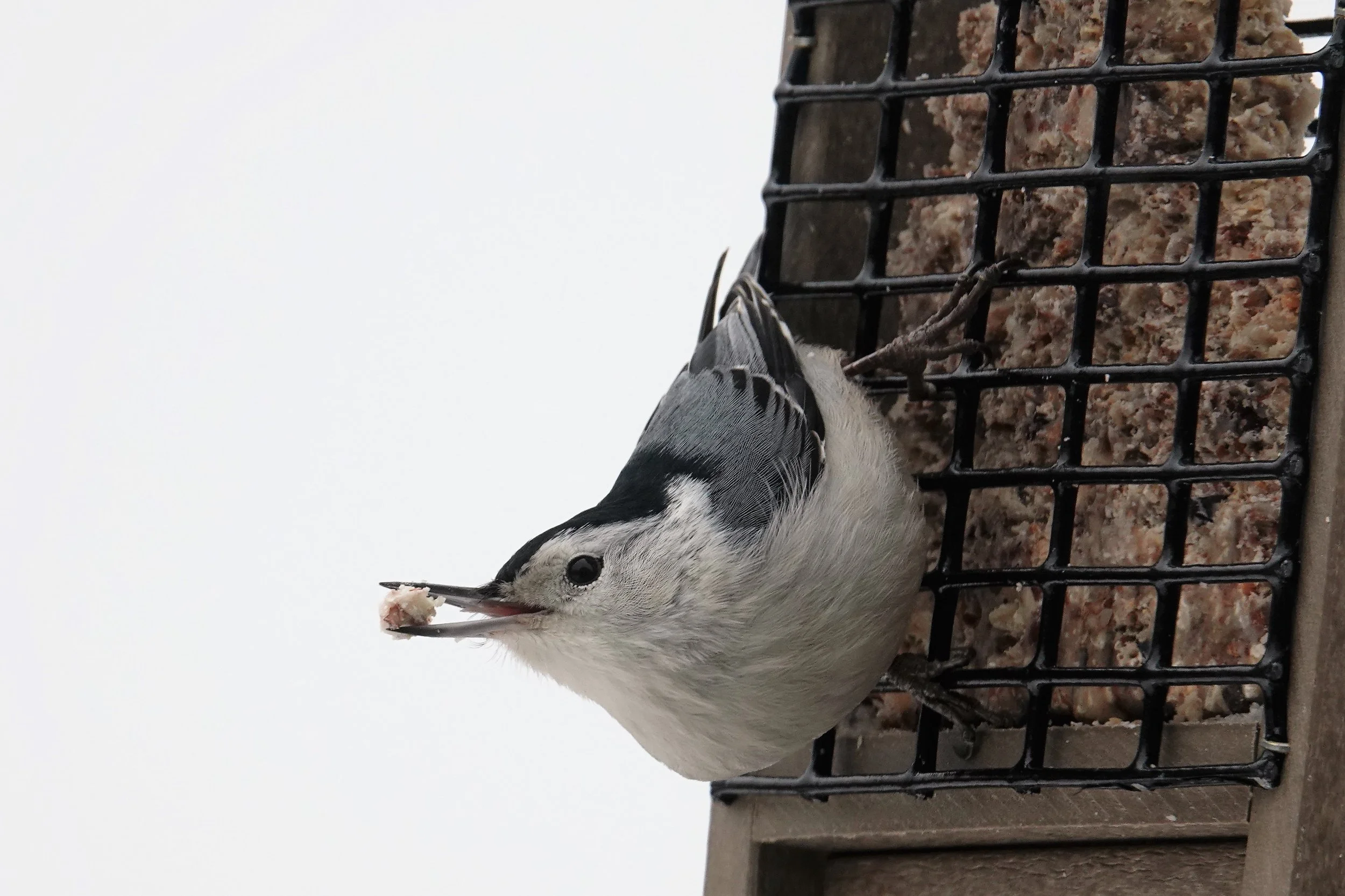Photo: White-breasted Nuthatch, Pamela Brown/Audubon Photography Awards
Evelyn Novins
It’s February, which often has the most severe winter weather. For this reason, back in February 1994, Illinois Congressman John Porter read a resolution into the Congressional Record naming February National Wild Bird Feeding Month, now generally known as National Bird Feeding Month. His resolution states that feeding wild birds, particularly through February, “benefits the environment by supplementing wild birds’ natural diet of weed, seed, and insects,” helping them survive the winter. He further stated that “backyard bird feeding is an entertaining, educational, and inexpensive pastime enjoyed by children and adults.” He suggested that the hobby could begin as simple feeding and progress to bird identification, to discovering the relationship between birds and specific seeds as well as the relationship between type of birds and the location of feeders. Congressional Record 140:16, p. E49, Feb. 23, 1994.
Because there are downsides to indiscriminate wild bird feeding, National Bird Feeding Month is not generally promoted by conservation organizations. ASNV, for example, through its Audubon at Home program, promotes helping wild birds by creating welcoming habitat, with native plants that nurture insects and other food sources, such as seeds and berries. The Cornell Lab, which also encourages creating good native habitat but recognizes the popularity of wild bird feeding, has created Project Feeder Watch, encouraging people who put up bird feeders to choose a two-day observation period during the winter months in which to tally bird sightings and submit the data as a citizen science project. At the same time, its Feeder Watch website provides tips on best practices to protect wild birds.
So, what are the downsides to wild bird feeding and how to mitigate them? A U.S. Fish & Wildlife Service article on feeding wild birds cites disease, predation, and collision as the greatest risks feeders pose.
European Starling and House Sparrows, Bevi Chignon/Audubon Photography Awards
First, disease: Birds swarming at feeders (often those that do not need help such as non-native House Sparrows and European Starlings) can readily transmit salmonella and E.coli, and feeders have been cited for spreading conjunctivitis in finches. So, keep the feeders clean! Clean feeders every couple of weeks and even more often during heavy use or wet weather. In addition to disassembling them and scrubbing off debris, run them through the dishwasher on a hot setting or scrub them in soap and boiling water. To ensure they are disinfected, soak them for 10 minutes in a bleach and water solution or for an hour in a weak vinegar solution, rinsing them well afterwards and drying them completely. See the Project Feeder Watch blog on cleaning for tips. In addition, make sure to rake under the feeders and clean away waste and moldy or spoiled food.
NOTE on Avian Influeza: At this writing Cornell Lab’s All About Birds has not advised people to take down bird feeders because of avian flu, unless they also keep poultry. Confirmed cases in Virginia have so far been limited to water birds (ducks, geese) and birds that feed on them (Bald Eagle, Black Vulture). If you are concerned, monitor the Cornell Lab website for updates.
The second greatest threat is predation: large groups of feeding birds invite predators. Sharp-shinned Hawks and Cooper’s Hawks are attracted to feeding swarms of birds, and you may find them haunting your feeders. If they become daily visitors and scare the birds away, take the feeders down for a few days to encourage the hawks to move on to other hunting grounds. The other very dangerous predator is the domestic cat. If you notice neighborhood cats hunting in your yard, try chasing them away with a good squirt of water. If they persist, you may have to remove your feeders permanently. ASNV works actively to educate people on the dangers cats pose to native wildlife and advocates for programs to decrease populations of free-roaming cats. See the article on its advocacy efforts in this issue of the Potomac Flier.
The third greatest threat is window collisions. Birds do not see glass and, confused by what is on the other side of a window or what shows up reflected in a window, they can crash into it, usually with fatal results. If you find birds are hitting your windows as they swarm your feeders, take steps to ensure that the birds see the windows as obstacles. Cornell’s All About Birds and the American Bird Conservancy publish information on window treatments that deter collisions. You also can watch a video on ASNV’s website that demonstrates options.
Backyard bird feeding provides us entertainment, education, and relaxation, and it’s up to us to ensure that we’re feeding birds in a responsible way. Keep the concerns we have outlined in mind, and, as a last note, make sure the food you provide is nutritious: NO bread, crackers, or popcorn, which provide no nutritional value for wild birds but can fill their stomachs without giving them the protein, fat and carbohydrates they need. Quality seeds such as black-oil sunflower, hulled sunflower, Nyjer (thistle), and whole peanuts are most nutritious to seed eating birds. Meal worms can attract wrens and bluebirds, and suet can attract woodpeckers, nuthatches, and other birds. The Project Feeder Watch site provides additional suggestions, and local feed stores can also be helpful resources.


